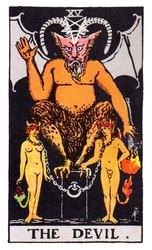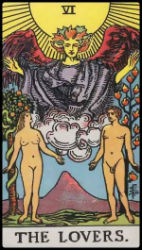
Not too long ago a friend asked me, “Well, what IS magic, anyway?” And it’s hard to explain, you see, because magic is all about bears and apples and cats eye marbles.
We encounter images like The Magician Tarot Card or Hollywood depictions of wizards and witches and we think that magic is very mysterious and as rare as a mustache on a frog. It’s certainly nothing that those of us who are ordinary mortals will encounter, unless we trip over a bottle with a genie in it.
Not true. Not true . . . magic is everywhere. We just don’t pay enough attention to see it.
I live in the mountains of Northern California and one of the things that comes along with mountains is bears. Yes, large, furry, fearsome, 500 pound ursine critters with giant claws and paws and huge, scary teeth.
But it’s not so bad. For the most part, bears mind their own business and humans mind theirs and seldom the twain shall meet. You might occasionally step out on your back porch at night and say, “Oh, shit, it’s a bear.” No problems. The bear stares at you, you stare at the bear, you slowly step back into your house, close the door and repeat, “Oh, shit, it’s a bear.”
I don’t doubt that the bear is probably standing in the yard thinking, “Oh, shit, it’s a human.”
The one time that bears can become problematic is in the Autumn when they need to fatten up before they hibernate. During that brief period of time, they will destroy anything that lies between them and food. If you have a shed with trash cans in it, they will rip the roof off to get to the garbage. They will eat goats and sheep if you leave them lying around at night. They’ve been known to tear the doors off of cars because the owner left a bag of dog kibbles inside. And they love, love, LOVE apples, which coincidentally ripen at exactly the same time that the bears get hungry.
When my partner, Carol, and I first moved to the mountains we purchased an old ranch style house. It was built in 1950 and several generations of several families had lived in the house before us. The deserted tree houses and forgotten toys lying in the weeds were testaments to the fact that many children had lived in that house and romped around on the surrounding property.
One of the things we were most excited about was that we had our very own apple grove on the hill behind the house. There were about a dozen, gnarled old trees and we were thrilled when they burst into beautiful white and pink blossoms during our first Spring there. The aroma of the blossoms was like something out of heaven. Fat, black and yellow bumble bees buzzed and droned from blossom to blossom and life was mellow.
As the summer progressed and the apples began to form and grow, we fantasized about harvesting them in the Autumn. We knew we’d make apple pies and apple fritters and apple butter. Perhaps we’d buy a small wine press and make apple cider or bottle apple vinegar. Maybe we’d fill the bathtub with apple sauce and just squish around in it.
Oh, we were feeling very organic! We were living in the country and we had a huge crop of apples coming ripe on our little farm. Which actually began to worry me a bit, as I strolled through the grove, counting the apples. I realized that, even on those few trees, there were hundreds of apples. Maybe thousands. It slowly began to dawn in the recesses of my mind that maybe thousands and thousands of apples coming ripe at the same time might not be such a swell idea. What in the holy hell were we going to DO with all of them?
It was right about then that I first heard about the bears.
One of our new neighbors dropped by unexpectedly and I was standing in the yard with him pretending that I liked it when neighbors dropped by unexpectedly. He was chewing on a match stick, eyeing the apples trees critically and he said, “Best keep all of them apples picked up when they fall or you’ll draw every bear in the county.”
Gulp. “Bears? We’ve got . . . bears?”
“Oh, yeah,” he replied. “The goddamned county is full of goddamned bears. Better not go out at night without a gun or they could tear you apart. Of course, they’re not near as bad as the mountain lions. The goddamned mountain lions like to jump out of a tree, bite your head and crush it like a goddamned egg. Goddamned, son of a bitch bears and mountain lions. Best keep those goddamned apples picked up or you’ll be goddamned sorry.”
All of which leads up to the fact that I could not, in fact, keep the goddamned apples picked up despite frantic, manic efforts. Apples fell like rain and covered the ground. They fell into the rain gutters on the house. They fell into pots full of flowers. They fell on my head and shoulders as I rushed through the apple grove with a rake and wheel barrow. They were everywhere. Whoever said that an apple doesn’t fall far from the tree never had a goddamned apple tree.
Now, I only mention this because of the cat’s eye marble.
As it turned out, the neighbor was right about the apples and the bears. There came the inevitable night when the dogs were howling and there was much huffing and puffing and the sounds of branching snapping in the apple grove. When I ventured out the next morning, several of the trees had been thoroughly trashed. The goddamned bear, not content to eat the goddamned apples that were on the ground, had ripped down dozens of branches and they lay broken and scattered around the grove.
As I stood there, muttering to myself and examining the humongous mounds of bear shit, there was a loud cracking noise to my immediate right. One of the larger branches had been broken nearly in two when the bear scaled the tree and it suddenly sagged almost to the ground.
And there, partially embedded in the wood at the point where the branch joined the tree, was a single cat’s eye marble.

I reached over and easily pulled it loose from the tree branch. As I stood there staring at the marble in my hand, I felt a shiver run up my spine and the hair on my neck stood on end. I realized that at some time, many, many years ago, a child stood by that very tree. Perhaps it was getting dark and her mother called her in from playing. Perhaps she was leaving a gift for the fairies. For whatever reason, she had carefully balanced a marble at the convergence of the tree and branch and then forgotten about it.
Through the years, the tree grew and grew and the branch gradually enveloped the marble, holding it there safe inside of the tree. Until I happened to be standing exactly next to the tree at the exact moment that the tree branch broke and revealed its treasure.
I felt as if the ghost of a small child was standing right there next to me, handing me that cat’s eye marble and saying, “Look what I’ve got, Mister.”
And that’s magic.
The odds against that happening are staggering. It’s impossible. Can’t happen.
But it did.
The thing about it is that I didn’t cast a spell or wave a wand at the tree or ask the elementals to perform a magical feat. It just happened and I was paying attention, so I saw it.
Maybe it was the ghost of that long ago child, but more likely it was the Universe laughing and saying, “Look what I’ve got, Mister. Can you see? Are you paying attention?”
Magic is out there. It happens all of the time. We just have to learn how to see it and when the Universe asks us to play with it, gather up our marbles and go.
*. *. *
PLEASE REMEMBER THAT MY E-BOOK, “JUST THE TAROT,” IS AVAILABLE ON AMAZON FOR LESS THAN THE PRICE OF WHOLE BAG FULL OF MARBLES. YOU SHOULD BUY A COPY – IT’S MAGICAL!














